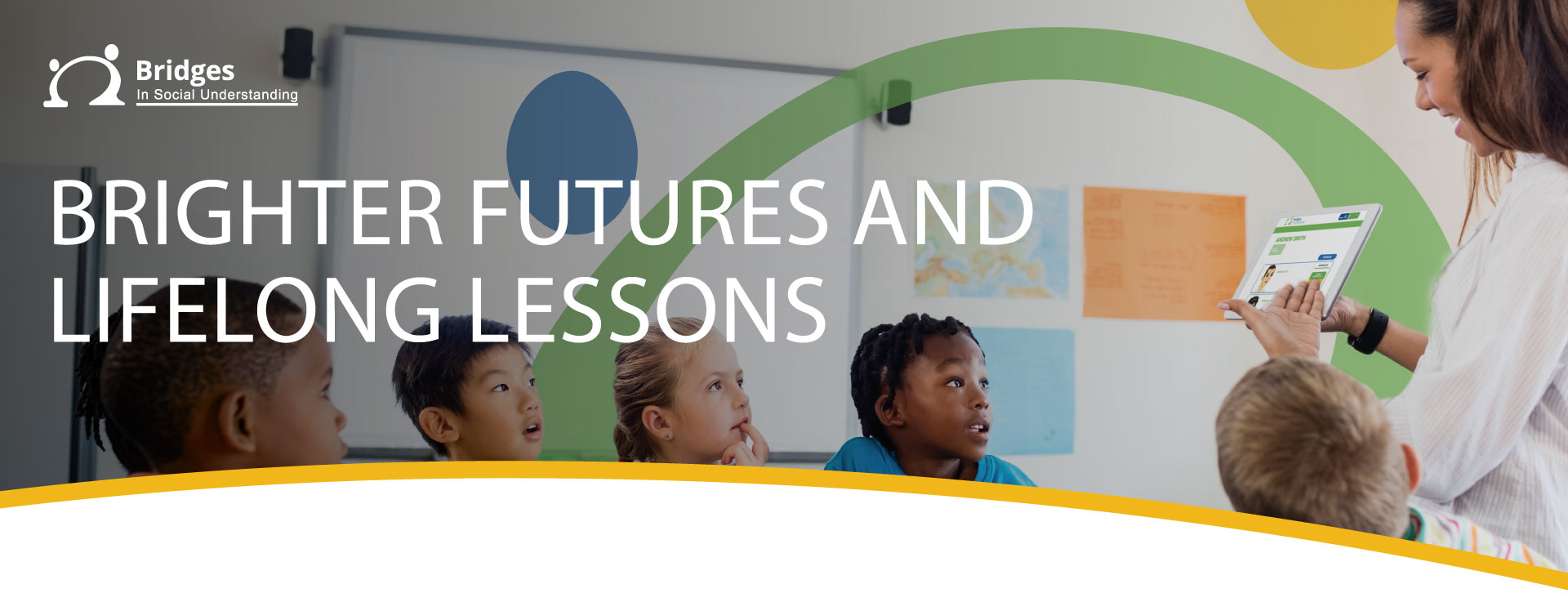
For professionals with students on the autism spectrum, creating the right support from a vast number of resources can be overwhelming. At Bridges, we’ve designed our curriculum with a practice based on evidence approach to help support
professionals teach social understanding systematically and sequentially, creating social learning that lasts.
As a Senior Speech and Language Therapist practising in Singapore, Helen Chandler-Yeo sees first-hand the impact the Bridges curriculum has on creating brighter social lives for her students. Helen works in private practice and is a Founding Member of
the Speech and Language Therapists Association in Singapore (SALTS). In this blog, Helen shares her experiences with Bridges and one student’s inspiring story.

![]()
“EVERY CHILD HAS DIFFERENT NEEDS, BUT BRIDGES WORKS FOR ALL OF THEM.”
“One of the students I’ve seen benefit most from the Bridges curriculum came to me around two years ago. When he first arrived, he struggled with social awareness, particularly around how his communication and language could affect others. Like similar students on the autism spectrum, losing games and understanding alternative points of view were also a challenge. As a result, he was becoming more socially isolated and had few friends at school.
As a speech-language therapist, I knew that at the core of his over-dominant communication style and often inappropriate social behaviour was a lack of social understanding. Having worked with Bridges for several years, I knew that their curriculum would help him to establish the thinking behind behaviours and to see other people’s point of view.”
![]()
“BUILDING SOCIAL SKILLS AND UNDERSTANDING”
THE BEST THING FOR ME AS A BUSY CLINICIAN IS THE THINKING HAS ALREADY BEEN DONE AND THE CONTENT RESOURCES ARE ALREADY PREPARED.
“I use Bridges as a resource for students with challenges like this because it provides me with a logical, detailed teaching framework that I can trust. It gradually builds up a child’s understanding of the what, how and why in social communication, which is something I knew this student needed.
One of the most effective and engaging parts of the Bridges curriculum that I’ve seen have a big impact on his social understanding is the use of visuals of relatable peers in each module. The ‘cartoon situation sequences’ and ‘video analysis’ tools have been very effective teaching resources and central in getting him to remember the concepts.
By guiding him through the Bridges modules systematically, he’s learned to notice how someone reacts to him and what that means in different situations. Before our work together, he had no awareness that his actions could play a part in creating a problem situation, but now he’s grown in awareness and considers other perspectives in social situations.”
![]()
“NEW CONFIDENCE AND SOCIAL SKILLS”
HE NOW HAS SO MANY FRIENDS I CAN’T EVEN COUNT THEM ALL.
“This new awareness means that before where he would routinely interrupt, he now automatically asks if he can say something, as well as accepting a ‘no, wait’ response.
What’s been remarkable about his progress since using Bridges is his move from social caution to social confidence. At school, he’s more flexible in joining activities that he might not enjoy, and he’s able to leave or reject an activity in an appropriately assertive way, knowing that it’s okay to disagree. He’s effective in groups and has also developed the confidence to confront a school bully, by articulating that their behaviour was unacceptable – in a socially appropriate way.
I’d contribute a large part of this new social confidence to the Bridges curriculum. The pre-and post-module measurements are a real encouragement to parents, practitioners and to the student; progress has always been made, it’s just a matter of how much.”
![]()
“CREATING LASTING LEARNING AND REAL RESULTS”
AT ONE POINT, HIS MUM WAS SO IMPRESSED WITH HIS PROGRESS SHE ASKED IF THEY NEEDED TO
CONTINUE.
“While it was encouraging for his parents to see success in his social development so early on in the curriculum, it’s important for them to see this as a long-term learning project. Bridges designed their modules so that learning themes are revisited later in the curriculum to build on their complexity and to extend students’ understanding as they grow.
For this student, it’s been particularly useful to have his mum join our sessions and then engage with the curriculum at home. By having her bring real-life events to apply to learning points, it’s helped him buy into the curriculum and learn from first-hand experiences. Not only has this encouraged his development and confidence, but it has also meant that Bridges’ lessons are reinforced at home with posters, visuals and key phrases that are used in the sessions at the clinic.“
![]()
“A BRIGHTER SOCIAL FUTURE”
“Where in the past this student has been socially cautious or unaware of how his actions can be challenging, thanks to the
help of Bridges, he has now flourished into a social, cheerful and generally confident pre-teen. With cognitively acquired
social understanding and an increased ability to regulate and modify his social behaviour, this student is better able to take
advantage of academic and social opportunities.”
For any teachers, specialists or professionals with students on the autism spectrum who are looking for ready-to-teach resources, try the Bridges curriculum for free in their 14-day free trial. Backed by over 40 years of clinical expertise and a practice based on evidence approach to social understanding, Bridges helps professionals and parents guide their children to help them learn the social skills they need for a happier, social life.

- Registered in England and Wales No.8556226
- Privacy Policy
- Faq


